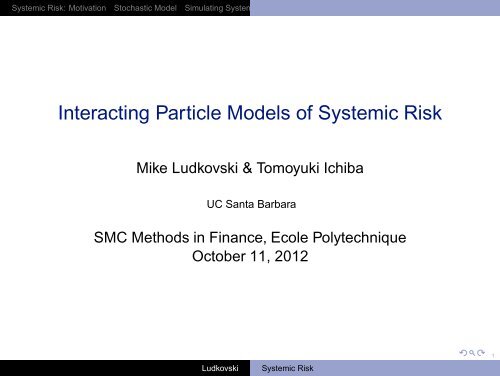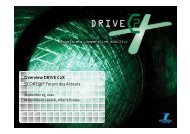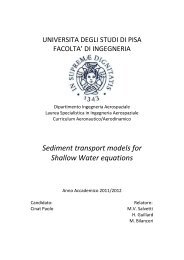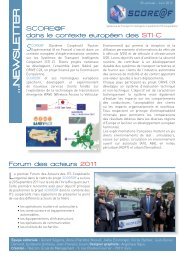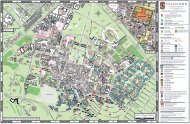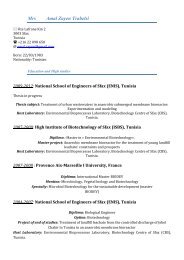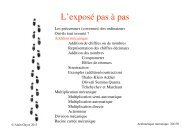Interacting Particle Systems for Systemic Risk
Interacting Particle Systems for Systemic Risk
Interacting Particle Systems for Systemic Risk
You also want an ePaper? Increase the reach of your titles
YUMPU automatically turns print PDFs into web optimized ePapers that Google loves.
<strong>Systemic</strong> <strong>Risk</strong>: Motivation Stochastic Model Simulating <strong>Systemic</strong> Shocks Examples of Rare Events<strong>Interacting</strong> <strong>Particle</strong> Models of <strong>Systemic</strong> <strong>Risk</strong>Mike Ludkovski & Tomoyuki IchibaUC Santa BarbaraSMC Methods in Finance, Ecole PolytechniqueOctober 11, 20121Ludkovski<strong>Systemic</strong> <strong>Risk</strong>
<strong>Systemic</strong> <strong>Risk</strong>: Motivation Stochastic Model Simulating <strong>Systemic</strong> Shocks Examples of Rare Events<strong>Systemic</strong> <strong>Risk</strong> in Banking NetworksBanking networks pose the most significant source of systemicrisk due to their high degree of interconnections and impact on theeconomyThese networks are highly complex, continuously evolve over timeand are subject to many ongoing shocksStochastic modeling of this problem remains open with multipleproposed approachesWe propose a new view using methods of <strong>Interacting</strong> <strong>Particle</strong><strong>Systems</strong>A flexible framework that is convenient <strong>for</strong> large-scale qualitativeanalysis while allowing <strong>for</strong> much granularity2Ludkovski<strong>Systemic</strong> <strong>Risk</strong>
<strong>Systemic</strong> <strong>Risk</strong>: Motivation Stochastic Model Simulating <strong>Systemic</strong> Shocks Examples of Rare EventsModeling ApproachFocus on the dynamic evolution of the whole network.Think of banks as particles or individuals that interact with otherbanks.Banks are born, grow over time, and eventually die (i.e. default).These mechanisms, especially default, involve mean-field-typeinteractions that create inter-dependencies.3Ludkovski<strong>Systemic</strong> <strong>Risk</strong>
<strong>Systemic</strong> <strong>Risk</strong>: Motivation Stochastic Model Simulating <strong>Systemic</strong> Shocks Examples of Rare EventsRelated LiteratureNetwork models: Cont et al. (2011a,b)Scaling Limits of Large Portfolio Losses: Giesecke et al. (2011),Cvitanic et al. (2011)Large deviations approaches: Giesecke et al. (2011),Papanicolaou (2012)<strong>Interacting</strong> diffusions: Ichiba and Fouque (2011), Fouque and Sun(2012)4Ludkovski<strong>Systemic</strong> <strong>Risk</strong>
<strong>Systemic</strong> <strong>Risk</strong>: Motivation Stochastic Model Simulating <strong>Systemic</strong> Shocks Examples of Rare EventsStochastic ModelX i (t) – net assets of bank i at date t.Each bank is born at epoch g i and dies at d i .Let I(t) = {i : g i ≤ t < d i } be the subset of banks alive at t.N(t) = |I(t)| is the size of the system.¯X(t) := 1 ∑N(t) i∈I(t) X i(t) – average bank size.X(t) ∈ ∪ n R n is the state process.5Ludkovski<strong>Systemic</strong> <strong>Risk</strong>
<strong>Systemic</strong> <strong>Risk</strong>: Motivation Stochastic Model Simulating <strong>Systemic</strong> Shocks Examples of Rare EventsSystem EvolutionN(t) is a birth-and-death process modeled through correspondingevent intensities.Birth rate λ + (N(t)) – larger when N(t) is small (less competition).Birth size ξ i ∼ F .Default rate λ − (X i (t)) – reduced-<strong>for</strong>m credit model; decreases inX i .Due to interconnections, defaults affect other banks:X i (d j +) = [1−θ(X j (d j −), X(d j −),ω)]·X i (d j −), where θ(·) is therandom proportion of bank i assets reduced due to default of bankj.Between defaults, assets grow at deterministic rate r i .Piecewise-deterministic model.6Ludkovski<strong>Systemic</strong> <strong>Risk</strong>
<strong>Systemic</strong> <strong>Risk</strong>: Motivation Stochastic Model Simulating <strong>Systemic</strong> Shocks Examples of Rare EventsIndividual dynamics:∫ tX i (t) = X i (g i )+g i∞∑r i X i (s)ds− θ(X j (d j −), X(d j −))X i (d j −)1 {gi
<strong>Systemic</strong> <strong>Risk</strong>: Motivation Stochastic Model Simulating <strong>Systemic</strong> Shocks Examples of Rare EventsSample Path of System Dynamics1.210.80.60.40.200 5 10 15 20 25 30 35 40 45 50Time t¯X(t)N(t)/N(0)1Default Size0.80.60.40.200 5 10 15 20 25 30 35 40 45 50170 Total DefaultsFigure: Trajectory of mean asset size X(t) and normalized number of banks N(t)/N(0).Bottom panel: default times and corresponding impact proportions θ(·). We take r = 0.02,λ − (x) = 0.05/(1+x), λ + (n) = 300/(1+n), ξ ∼ Exp(1) and N 0 = 100 andθ(x j ,¯x) ∼ Beta( x j100¯x , 1). Ludkovski <strong>Systemic</strong> <strong>Risk</strong>8
<strong>Systemic</strong> <strong>Risk</strong>: Motivation Stochastic Model Simulating <strong>Systemic</strong> Shocks Examples of Rare EventsModel FeaturesThe system is self-stabilizing: when N(t) is large there are moredefaults causing X(t) to fall; when N(t) is small, birth rate ishigher.Lifetime of each individual bank is finite.High turnover microscopically; stable macroscopically.If λ − (x) > 0 is bounded away from zero then with positiveprobability the system will eventually completely collapse andregenerate. Large shocks are intrinsic.Numerous add-ons are possible: diffusion terms in X i (t); morecorrelations; default cascades; inhomogeneous dynamics, etc.9Ludkovski<strong>Systemic</strong> <strong>Risk</strong>
<strong>Systemic</strong> <strong>Risk</strong>: Motivation Stochastic Model Simulating <strong>Systemic</strong> Shocks Examples of Rare EventsRecurrencePropositionUnder technical conditions on λ − and θ, the system has an invariantdistribution on ∪ n R n .Rule out explosion (intrinsic defaults + interaction); births allowregeneration.Sufficient condition: ∫ ∞0 λ− (x 0 e rt ) dt = +∞ <strong>for</strong> all x 0 .10Ludkovski<strong>Systemic</strong> <strong>Risk</strong>
<strong>Systemic</strong> <strong>Risk</strong>: Motivation Stochastic Model Simulating <strong>Systemic</strong> Shocks Examples of Rare Events<strong>Systemic</strong> ShocksWhile the system will eventually collapse and regenerate, largeshocks are very rare.We are interested in understanding the mechanism/frequency ofsuch shocks in terms of model ingredients.Focus on the case of moderately large N(0) – still far frommean-field limit.Large shock = N(t) or X(t) "small".e.g. let τ = inf{t : N(t) < n}. Wish to compute:◮ P(N(T) < n);◮ P(τ < T);◮ Path-distribution of X(·) on [0,τ).Monte Carlo methods seem to be the only feasible tool in thisdirection.11Ludkovski<strong>Systemic</strong> <strong>Risk</strong>
<strong>Systemic</strong> <strong>Risk</strong>: Motivation Stochastic Model Simulating <strong>Systemic</strong> Shocks Examples of Rare Events<strong>Systemic</strong> ShocksWhile the system will eventually collapse and regenerate, largeshocks are very rare.We are interested in understanding the mechanism/frequency ofsuch shocks in terms of model ingredients.Focus on the case of moderately large N(0) – still far frommean-field limit.Large shock = N(t) or X(t) "small".e.g. let τ = inf{t : N(t) < n}. Wish to compute:◮ P(N(T) < n);◮ P(τ < T);◮ Path-distribution of X(·) on [0,τ).Monte Carlo methods seem to be the only feasible tool in thisdirection.11Ludkovski<strong>Systemic</strong> <strong>Risk</strong>
<strong>Systemic</strong> <strong>Risk</strong>: Motivation Stochastic Model Simulating <strong>Systemic</strong> Shocks Examples of Rare EventsGenerating Large ShocksThink of one realization of X(·) as a "scenario".Naive use of Monte Carlo to generate a lot of scenarios tounderstand behavior of big shocks is very inefficient when thecorresponding probabilities are small.Variance Reduction is a must.Importance Sampling is hard to implement as it’s not clear how tochoose a new measure <strong>for</strong> X.Use Empirical IS Method originally proposed in Del Moral andGarnier (2005); elaborated in Carmona et al (2009).12Ludkovski<strong>Systemic</strong> <strong>Risk</strong>
<strong>Systemic</strong> <strong>Risk</strong>: Motivation Stochastic Model Simulating <strong>Systemic</strong> Shocks Examples of Rare EventsGenerating Large ShocksThink of one realization of X(·) as a "scenario".Naive use of Monte Carlo to generate a lot of scenarios tounderstand behavior of big shocks is very inefficient when thecorresponding probabilities are small.Variance Reduction is a must.Importance Sampling is hard to implement as it’s not clear how tochoose a new measure <strong>for</strong> X.Use Empirical IS Method originally proposed in Del Moral andGarnier (2005); elaborated in Carmona et al (2009).12Ludkovski<strong>Systemic</strong> <strong>Risk</strong>
<strong>Systemic</strong> <strong>Risk</strong>: Motivation Stochastic Model Simulating <strong>Systemic</strong> Shocks Examples of Rare EventsFeynman Kac PotentialsConsider a collection of J scenario path-particles X (j) , j = 1,...,J.The particles evolve according to a Feynman-Kac measurechange:d˜PdP | F T= 1Z TT ∏k=1G k (X)where G k are the Feynman-Kac potentials on the increasing pathspaces of length k: G k (X) ≡ G k (X(t 0 ), X(t 1 ),..., X(t k )).Sequential algorithm: At dates t k re-sample particles usingweights w j := G k(X (j) )∑l G k(X l ) .Propagate particles independently using P-dynamics.14Ludkovski<strong>Systemic</strong> <strong>Risk</strong>
<strong>Systemic</strong> <strong>Risk</strong>: Motivation Stochastic Model Simulating <strong>Systemic</strong> Shocks Examples of Rare EventsIS ApproximationApproximate:E[f(X(T))] = E[f(X(T))= η T (˜f(X))T∏k=1G −1kT∏η k (G k ),k=1η k (g) = γ k (g)/γ k (1)(X)]T∏G k (X)k=1γ k (g) := E [ g(X)˜f(X) := f(X(T)) T ∏k=1k∏G l (X) ] .l=1G −1k(X)Obtain an unbiased estimator based onη (J)k(G k ) = 1 ∑ JJ j=1 G k(X (j) ).Typical ( potential: G k (X (j) (t 0 ), X (j) (t 1 ),... ) X (j) (t k )) =exp α(min l≤k−1 N(t l )−min l≤k N(t l )) (multiplicative).Preference to particles where N(t) is setting new lows.15Ludkovski<strong>Systemic</strong> <strong>Risk</strong>
<strong>Systemic</strong> <strong>Risk</strong>: Motivation Stochastic Model Simulating <strong>Systemic</strong> Shocks Examples of Rare EventsImportance Sampling140120Original MeasureEmpirical IS <strong>for</strong> low mint N(t)10080604020040 50 60 70 80 90 100 110mint N(t)Figure: Histogram of 400 MC simulations: under original measure (independent scenarios) andusing a F-K potential G k (X) = exp(−α(min l≤k N(l)−min l
<strong>Systemic</strong> <strong>Risk</strong>: Motivation Stochastic Model Simulating <strong>Systemic</strong> Shocks Examples of Rare EventsAlgorithm DetailsSufficient to have just a few hundred particles.The crux of the method is in choosing a good potential G k (inparticular the potential strength α) – must be adapted to theproblem at hand.Resample <strong>for</strong> example every 1 period (in between use exactsimulation of the birth-and-death process N(t) and correspondingX (j) ), t k = k.By storing the path genealogies of the particles surviving at Thave access to (unbiased) conditional distribution of X(·) be<strong>for</strong>ethe shock (note: path degeneracy).The method dynamically twists the measure while keeping thesimulation part very simple.17Ludkovski<strong>Systemic</strong> <strong>Risk</strong>
<strong>Systemic</strong> <strong>Risk</strong>: Motivation Stochastic Model Simulating <strong>Systemic</strong> Shocks Examples of Rare EventsAlgorithm DetailsSufficient to have just a few hundred particles.The crux of the method is in choosing a good potential G k (inparticular the potential strength α) – must be adapted to theproblem at hand.Resample <strong>for</strong> example every 1 period (in between use exactsimulation of the birth-and-death process N(t) and correspondingX (j) ), t k = k.By storing the path genealogies of the particles surviving at Thave access to (unbiased) conditional distribution of X(·) be<strong>for</strong>ethe shock (note: path degeneracy).The method dynamically twists the measure while keeping thesimulation part very simple.17Ludkovski<strong>Systemic</strong> <strong>Risk</strong>
<strong>Systemic</strong> <strong>Risk</strong>: Motivation Stochastic Model Simulating <strong>Systemic</strong> Shocks Examples of Rare EventsExamples of Rare EventsProbability of a very low number of banks (or very low total bankassets) at a fixed date T .Probability of a major shock in the next T periods.Relationship between low N(T) and low X(T).Example:P(min s≤50 N(s) < 80) ≃ 0.011P(min s≤50 N(s) < 70) ≃ 7.3·10 −5P(min s≤50 N(s) < 60) ≃ 1.2·10 −7 .18Ludkovski<strong>Systemic</strong> <strong>Risk</strong>
<strong>Systemic</strong> <strong>Risk</strong>: Motivation Stochastic Model Simulating <strong>Systemic</strong> Shocks Examples of Rare EventsExamples of Rare EventsProbability of a very low number of banks (or very low total bankassets) at a fixed date T .Probability of a major shock in the next T periods.Relationship between low N(T) and low X(T).Example:P(min s≤50 N(s) < 80) ≃ 0.011P(min s≤50 N(s) < 70) ≃ 7.3·10 −5P(min s≤50 N(s) < 60) ≃ 1.2·10 −7 .18Ludkovski<strong>Systemic</strong> <strong>Risk</strong>
<strong>Systemic</strong> <strong>Risk</strong>: Motivation Stochastic Model Simulating <strong>Systemic</strong> Shocks Examples of Rare EventsGenealogy of the path-particles130125120115110N(t)105100959085800 10 20 30 40 50 60Time tFigure: Three particle genealogies conditional on a high number of defaults.20Ludkovski<strong>Systemic</strong> <strong>Risk</strong>
<strong>Systemic</strong> <strong>Risk</strong>: Motivation Stochastic Model Simulating <strong>Systemic</strong> Shocks Examples of Rare EventsNumerical ChallengesFor estimating rare event probabilities we have a well-developedtheory based on large deviationsThe method provides an estimate of the CoV that can be used toguide potential function selection and evaluation of theper<strong>for</strong>mance.In practice, these estimates are quite stable.We are also interested in the conditional trajectories to rareevents. Here it is hard to check accuracy/efficiency. Numericalevidence suggests that different potentials are more efficient <strong>for</strong>this task.Shape of the potential strongly affects the shape of the ancestraltree (reward the fit vs. cull the weak)Splitting Methods vs. Exponential Tilting.21Ludkovski<strong>Systemic</strong> <strong>Risk</strong>
<strong>Systemic</strong> <strong>Risk</strong>: Motivation Stochastic Model Simulating <strong>Systemic</strong> Shocks Examples of Rare EventsWork in ProgressHave a framework <strong>for</strong> simulating dynamic defaults in an interactingnetwork.Understanding the relationships and mechanisms of rare eventsunlocks many interesting phenomena (a cascade of small defaultsvs. a single large event).Another analytic tool is the LLN scaling limit as N(0) → ∞(average out the noise from the defaults and births).THANK YOU!22Ludkovski<strong>Systemic</strong> <strong>Risk</strong>
<strong>Systemic</strong> <strong>Risk</strong>: Motivation Stochastic Model Simulating <strong>Systemic</strong> Shocks Examples of Rare EventsWork in ProgressHave a framework <strong>for</strong> simulating dynamic defaults in an interactingnetwork.Understanding the relationships and mechanisms of rare eventsunlocks many interesting phenomena (a cascade of small defaultsvs. a single large event).Another analytic tool is the LLN scaling limit as N(0) → ∞(average out the noise from the defaults and births).THANK YOU!22Ludkovski<strong>Systemic</strong> <strong>Risk</strong>
<strong>Systemic</strong> <strong>Risk</strong>: Motivation Stochastic Model Simulating <strong>Systemic</strong> Shocks Examples of Rare EventsToy ExampleX t = W t − cN t jump-diffusion model (c ≫ 1)Rare event is : A = {X T ∈ −da}G(x t , x t−1 ) = exp(−α(x t − x t−1 )) gives a strong preference toparticles that jump.G(x t , x t−1 ) = exp(−α(x t − x t−1 ))∧M is more "democratic" andcreates a more diverse ancestral tree with minimal efficiency loss0G = exp(−0.4(x p−x p−1))−10−20−300 5 10 15 20100−10−20−30G = exp(−0.4 max(x p−x p−1,18))−400 5 10 15 20Figure: Ancestral Trees <strong>for</strong> 2 different FK potentials.23Ludkovski<strong>Systemic</strong> <strong>Risk</strong>
<strong>Systemic</strong> <strong>Risk</strong>: Motivation Stochastic Model Simulating <strong>Systemic</strong> Shocks Examples of Rare EventsReferencesCarmona, R.; Fouque, J. and Vestal, D.<strong>Interacting</strong> particle systems <strong>for</strong> the computation of rare credit portfolio lossesFinance and Stochastics (2009), 13, 613–633.Cvitanic, J.; Ma, J. and Zhang, J.Laws of Large Numbers <strong>for</strong> Self-Inciting Correlated Defaults.Preprint, 2011.Giesecke, K.; Spiliopoulos, K. and Sowers, R.Default Clustering in Large Portfolios: Typical and Atypical EventsPreprint, 2011Ichiba, T. and Fouque, J.Stability in a model of inter-bank lendingPreprint, 201124Ludkovski<strong>Systemic</strong> <strong>Risk</strong>


